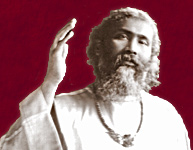Volume IX - The Unity of Religious IdealsPart IVRAMARama, the great prophet and ideal of the Hindus, was at the same time an example of the incarnation of a godhead. The character and history of Rama is described by Valmiki in the great epic Ramayana. The training, which was given to Rama by a great Rishi named Vashishta, was in order to bring forth that kingdom of God which is hidden in the heart of man. In this respect Rama was not only an ideal for the Hindus of that particular age, but a model to mold the character of those who tread the spiritual path in any age. Rama was a prince by birth, but was sent to be trained by a sage, with whom he lived in the solitude of a life of both study and play. He was not only taught to read and write, but he was also trained in athletic exercises and sports, and in all manner of warfare. This shows what kind of education the ancient people had, and education in all aspects of life. And being trained thus, Rama completed his studies when he was in the prime of his youth. The Hindus have always considered the Ramayana the most sacred scripture. The Brahmin recites this story in a poetic form, to which the devotees of the Master listen for hours without tiring of it, for they take it as their religious training. The most interesting part of Rama's life is his marriage. In ancient times it was the custom for the husband to be chosen. This custom arose because of the tendency to warfare. Over every little disagreement the princes of the time rose up in arms, even in such matters as marriage. In order to avoid war, the father of Sita invited all the princes and potentates of his land and gave the right of selection to his daughter. A time was appointed for them all to gather in the royal gallery, adorned with their regal ornaments and decorations. Rama had lived a simple life; he had not yet known what princely life meant, for he was being trained under a saint, where he ate the same food and wore the same simple clothes as the sage, and lived with him in the woods in the solitude. Yet the brightness of the soul shines out even without ornaments. When Sita entered this assembly, with a garland of flowers in her hands, her first glance fell upon Rama, and she could not lift her eyes from that ideal of her soul to look at anyone else, for her soul recognized the pearl of its heart. Sita, without a moment's hesitation, came and put the garland on the neck of that youth, so simple and unassuming, standing with an innocent expression behind all the shining hosts. Some marveled at this choice, but many more became like glowing fire with envy and jealousy. Among them the one who was most upset was the King of Lanka, Ravana. For Sita was not only known as the most beautiful princess of the time, but she was also called Padmani, the Ideal Maiden. As in Rama his character was an example, so in Sita the ideal character was born. Later, the two were separated. Sita, who had followed Rama in his twelve years of Vanavasa, which means roaming in the forest was once left alone in the woods, for Rama had gone to fetch some water. At that point Sita disappeared, and only after great difficulty and grief were her traces found. She had been taken prisoner by Ravana. She had steadfastly lived for Rama in this captivity, and would not yield to Ravana's tempting and threats. In the end victory was won. Rama fought a battle with Ravana and brought Sita home again. This story shows how life is a struggle for everyone, to a greater or lesser degree. The outer nature of the struggle may be different for everyone, but at the same time no one can live in the midst of this world and be without a struggle. In this struggle the one who wins in the end has fulfilled the purpose of his life; the one who loses in the end has missed his purpose. The life of Rama suggests that apart from spiritual strife
the struggle in the world is the first thing to face; and if
one keeps to one's own ideal through every test and trial in
life, one will surely arrive at a stage when one will be victorious.
It does not matter how small the struggle may be, but it is
the victory won at the end of every struggle which is the power
that leads man further on the path towards life's goal. Man's
life, however great and spiritual, has its limitations. Before
some conditions in life even the greatest man on earth, the
most powerful soul, will for a moment seem helpless. But it
is not the beginning that counts, it is the end. It is the last
note that a great soul strikes which proves that soul to be
real and true. checked 18-Oct-2005 |

